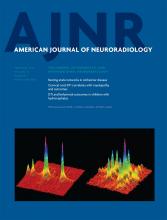Index by author
Berkovic, S.F.
- PediatricsOpen AccessBilateral Posterior Periventricular Nodular Heterotopia: A Recognizable Cortical Malformation with a Spectrum of Associated Brain AbnormalitiesS.A. Mandelstam, R.J. Leventer, A. Sandow, G. McGillivray, M. van Kogelenberg, R. Guerrini, S. Robertson, S.F. Berkovic, G.D. Jackson and I.E. SchefferAmerican Journal of Neuroradiology February 2013, 34 (2) 432-438; DOI: https://doi.org/10.3174/ajnr.A3427
Berthelet, F.
- NeurointerventionYou have accessThrombosis Heralding Aneurysmal Rupture: An Exploration of Potential Mechanisms in a Novel Giant Swine Aneurysm ModelJ. Raymond, T.E. Darsaut, M. Kotowski, A. Makoyeva, G. Gevry, F. Berthelet and I. SalazkinAmerican Journal of Neuroradiology February 2013, 34 (2) 346-353; DOI: https://doi.org/10.3174/ajnr.A3407
Boulton, M.
- NeurointerventionYou have accessCanadian Experience with the Pipeline Embolization Device for Repair of Unruptured Intracranial AneurysmsC.J. O'Kelly, J. Spears, M. Chow, J. Wong, M. Boulton, A. Weill, R.A. Willinsky, M. Kelly and T.R. MarottaAmerican Journal of Neuroradiology February 2013, 34 (2) 381-387; DOI: https://doi.org/10.3174/ajnr.A3224
Brisman, J.L.
- NeurointerventionYou have accessWhat's Coming Down the Pipe—And Should We Be Excited, Concerned, or Both?J.L. BrismanAmerican Journal of Neuroradiology February 2013, 34 (2) 388-390; DOI: https://doi.org/10.3174/ajnr.A3425
Broussalis, E.
- NeurointerventionYou have accessComparison of Stent-Retriever Devices versus the Merci Retriever for Endovascular Treatment of Acute StrokeE. Broussalis, E. Trinka, W. Hitzl, A. Wallner, V. Chroust and M. Killer-OberpfalzerAmerican Journal of Neuroradiology February 2013, 34 (2) 366-372; DOI: https://doi.org/10.3174/ajnr.A3195
Brugger, P.C.
- PediatricsYou have accessMR Spectroscopy of the Fetal Brain: Is It Possible without Sedation?V. Berger-Kulemann, P.C. Brugger, D. Pugash, M. Krssak, M. Weber, A. Wielandner and D. PrayerAmerican Journal of Neuroradiology February 2013, 34 (2) 424-431; DOI: https://doi.org/10.3174/ajnr.A3196
Carter, R.E.
- FELLOWS' JOURNAL CLUBSpineYou have accessCervical Spine MR Imaging Findings of Patients with Hirayama Disease in North America: A Multisite StudyV.T. Lehman, P.H. Luetmer, E.J. Sorenson, R.E. Carter, V. Gupta, G.P. Fletcher, L.S. Hu and A.L. KotsenasAmerican Journal of Neuroradiology February 2013, 34 (2) 451-456; DOI: https://doi.org/10.3174/ajnr.A3277
The authors sought to determine if Hirayama disease in North America has the same imaging findings as it does in Asia. They assessed imaging studies in 21 patients and looked for loss of attachment of posterior dura, lower cord atrophy and high T2 signal, loss of cervical lordosis, and anterior dural shift in flexion. These 4 findings were able to discriminate patients from healthy controls. MR imaging findings in white North American patients with Hirayama disease include loss of attachment on neutral images and forward displacement of the dura with flexion. Findings are often present on neutral MR images and, in the appropriate clinical scenario, should prompt flexion MR imaging to evaluate anterior dural shift.
Castillo, M.
- EditorialsYou have accessRecognizing Famous FacesM. CastilloAmerican Journal of Neuroradiology February 2013, 34 (2) 257-258; DOI: https://doi.org/10.3174/ajnr.A3100
Cen, S.Y.
- EDITOR'S CHOICESpineYou have accessDiffusion Tensor Imaging Correlates with the Clinical Assessment of Disease Severity in Cervical Spondylotic Myelopathy and Predicts Outcome following SurgeryJ.G.A. Jones, S.Y. Cen, R.M. Lebel, P.C. Hsieh and M. LawAmerican Journal of Neuroradiology February 2013, 34 (2) 471-478; DOI: https://doi.org/10.3174/ajnr.A3199
The relationship between DTI findings and clinical severity of cervical myelopathy due to spondylosis was studied in 30 patients. Low fractional anisotropy correlated with initial clinical assessments and patients with high FA showed better outcome. T2 signal intensity was associated with functional status but did not predict outcome whereas degree of stenosis lacked correlation with all clinical parameters. Thus, DTI may be a useful diagnostic tool for assessing disease severity in these patients and its predictive value regarding postoperative outcome may improve surgical decision making.
Chaudhry, S.A.
- FELLOWS' JOURNAL CLUBNeurointerventionOpen AccessMicrocatheter to Recanalization (Procedure Time) Predicts Outcomes in Endovascular Treatment in Patients with Acute Ischemic Stroke: When Do We Stop?A.E. Hassan, S.A. Chaudhry, J.T. Miley, R. Khatri, S.A. Hassan, M.F.K. Suri and A.I. QureshiAmerican Journal of Neuroradiology February 2013, 34 (2) 354-359; DOI: https://doi.org/10.3174/ajnr.A3202
This study addresses the relationship among procedure time, recanalization, and clinical outcomes in patients with acute ischemic stroke undergoing endovascular treatment. Demographics, NIHSS scores before and 1 day after the procedure, and modified Rankin Scale scores were assessed in 209 patients. Patients with procedure times ≤30 minutes had lower rates of unfavorable outcome at discharge compared with patients with procedure times ≥30 minutes. Rates of favorable outcomes in endovascularly treated patients after 60 minutes were lower than rates observed with placebo treatment. Unfavorable outcome was positively associated with age, admission NIHSS strata, and longer procedure times.








